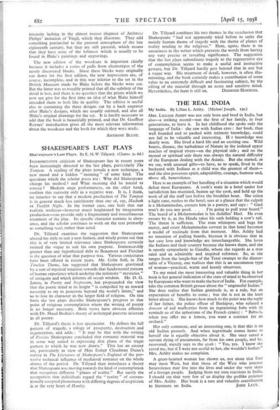NEO-CLASSICISM
The Illustrations of William Blake for Thornton's Virgil. (Nonesuch Press. 15s.)
THE history of the Classical Revival in England at the end of the eighteenth century is still so obscure that any documents which throw light on it are welcome. Thomas Banks, R.A., was among its most important exponents, and it is surprising that up till now no one has made any attempt to bring together the known facts about his life and works. He was twenty years Flaxman's senior and had started firmly on the course of Neo-Classicism before the latter was working. He studied for seven years in Rome, from 1772 to 1779, and he was then in contact with all the most important figures in the classical movement which had been in progress for some time, though the group had just suffered its greatest blow in the death of Winckelmann. At this time Banks produced bas-reliefs which have all the cold-bloodedness of Canova's statues, and much of their skill and placid purity. But when he came back to England, there crept into his style some of that almost Expres- sionist emotionalism which appears in all the English classical art of this period, even in Flaxman. There are figures express- ing anguish, in the " Thetis " or the " Falling Titan," which have a real grandeur ; and a corpse in the design for a monu- ment for Captain Cook might have been drawn by Blake. This element of unrest which is apparent in all the more radical artists—radical politically as well as artistically—at this time hardly survives the French Revolution. His later works become more conventionally classical ; all trace of emotion is squeezed out of them ; and elegance gives way to expression. The mourning figures in the later tombs cover their faces, so that no trace of grief shall be visible ; and no gesture hints at any feeling beyond decent regret.
Mr. Bell has brought together a great quantity of entirely new material about this artist, in the form of letters and docu- ments, as well as in photographs of unidentified or forgotten works. It is, however, a pity that he has made no attempt to put this material into a consecutive narrative. As it is at present arranged the text, mainly consisting of Banks' letters, is constantly interrupted by lengthy notes on all the characters mentioned in them. These notes again contain much that is interesting, but this could all have been conveyed in a much more intelligible form if part of it had been used to link up the documents into a narrative and the rest consigned to proper footnotes. In other respects the book is admirably arranged, and the plates, of which there are forty-three, are well repro- duced from good photographs.
In the works of Banks we sometimes see a frigid mind showing a point of passion, but in Blake's illustrations to Thornton's Virgil we have the opposite phenomenon, namely a passionately emotional artist appearing in his calmest and most pastoral mood. The woodcuts have, of course, an imaginative
intensity lacking in the almost rococo elegance of Ambrose Philips' imitation of Virgil, which they illustrate. They add something patriarchal to the pastoral atmosphere of the late eighteenth century, but they are still pastoral, which means that they have none of the loftiness which is usually to be found in Blake's paintings and engravings.
The new edition of the woodcuts is important chiefly because it includes a series of pulls from electrotypes of the newly discovered blocks. Since these blocks were originally cut down for the first edition, the new impressions are, of course, incomplete, and in this way inferior to the set in the British Museum made by Blake before the blocks were cut. But the latter was so roughly printed that all the subtlety of the detail is lost, and there is no question that the prints which we now see give for the first time an idea of what Blake himself intended them to look like in quality. The edition is useful also in containing the three designs cut by a hack engraver after Blake's designs, which are usually omitted, and also all Blake's original drawings for the set. It is hardly necessary to add that the book is beautifully printed, and that Dr. Geoffrey Keynes' introduction gives all the most relevant information about the woodcuts and the book for which they were made.
ANTHONY BLUNT.







































 Previous page
Previous page